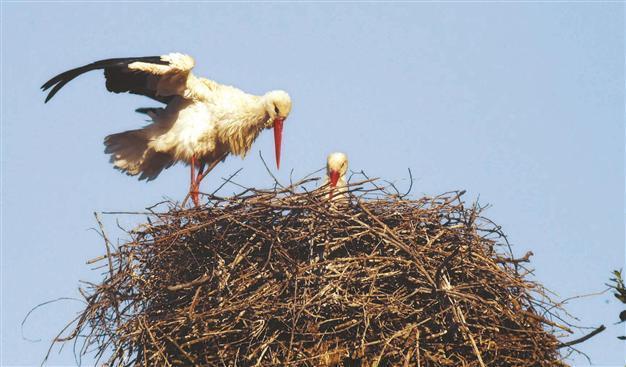Migrant birds of Gökova Gulf, victims of wires
MUĞLA - Anadolu Agency

Migratory birds have become the symbol of Akçapınar village. But their numbers continue to decrease every year. AA photos
Storks that come to the western province of Muğla’s Gulf of Gökova in the months of spring for incubation, propagation and learning to fly, become victims of electrical wires in the Akçapınar neighborhood, known as stork village.The Gökova area fascinates visitors with its natural beauties like the “green tunnel,” formed by hundreds of eucalyptus trees on the roadside, also draws attention for nests of immigrant storks on electrical wires and the roofs of houses in Akçapınar. In the region, tourists document the life of storks with their cameras and spend the rest of the day eating regional foods in authentic village houses.
The Akçapınar headman Şükrü Arslan said after many trees had been cut in the village, storks began making their nest on electrical wires. He said that the number of immigrant storks was increasing every other year. “The number of storks coming to the village in March and April in the incubation period was around 100 couples in 1980s. This year it is 10,” he said, and continued:
“There were too many storks coming to the village in the past. They did not fit into nests and took our clothes in our gardens to make nests. The decrease in the number of storks continues every year.”
Fifteen nests
Arslan said there 15 stork nests in their village, adding, “Storks are making these nests. They incubate in the first week of April and begin giving birth in June. The chicks learn to fly during the same month.
Each stork gives birth to nearly four chicks. Then it grows to some 100 storks in 15 nests within a period of five months. But when trying to fly, the chicks die in front of us because of the electrical wires.”
Arslan said that many tourists came to the village from abroad to record the incubation, reproduction and flight of the storks. “Tourists come to the region from the Netherlands, Britain and Germany, take photos of the storks in our village. They spend one day in the village, visit historical places and shop. They tell people abroad that Akçapınar is a stork village,” he said.
Arslan said that since the first day of his mission, he had been making effort for the transfer of electrical wires where storks nest, to the underground and continued:
“I have applied to relevant officials about this issue, but did not receive any result. Muğla is a metropolitan city and we have become a neighborhood. We applied again to the Metropolitan Municipality for storks to have a safer life in our village, which draws interest as a stork village. Because these storks have been coming to this village for centuries, incubate here and teach their chicks how to fly. No other village has this many stork nests. We are waiting for help from officials for the protection of this value. Citizens feel uneasy when storks do not come here. We understand the weather conditions with the coming of the storks. When a stork dies here because of electrical wires, our villages feel sorry, like losing their own child.”
He said that storks had become the symbol of Akçapınar and united with the locals in the neighborhood, noting that their efforts would continue to protect storks.
















